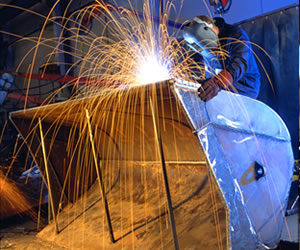
The other day a mobile welder was telling us that he only welds mild steel. The reason he wasn’t taking on stainless steel or aluminum jobs was that he feared getting Parkinson disease. It was a wake-up call: this is a perception welding has acquired. And it’s not a good perception. How are you going to attract intelligent young people into the welding industry, if they think their health and vitality will be threatened? They have other options. Let the people who have limited or no options choose to weld.
It’s not only aluminum and stainless steel welding that’s being scrutinized; mild steel welding is being watched carefully, too. The buzz word with mild steel is manganese.

Manganese is one of those elements that is good for us but too much is not good either. Manganese is essential for normal development and body function. Though it isn’t very often reported, a deficiency in manganese has been associated with a variety of diseases in human.
The bigger concern in the welding industry has been overexposure to manganese.

In the welding industry, manganese is found in all mild steels. It is always used in steel alloys to improve metallurgical properties by neutralizing the effects of sulfur and preventing oxygen from contaminating the metal.
In welding, manganese makes up to 0.2% to 10 % of the fumes. These levels can become much higher depending on the steels (special steels) or if heavy duty welding is being done.
Flux core welding (FCAW) contains 1.5% to 2% manganese for deoxidizing and alloying.
To restore the manganese lost by the heat during welding, manganese up to 15% by weight can be used as flux agents in the coatings of SMAW electrodes and FCAW electrodes. Depending on the above mentioned factors, manganese generally makes up from 0.2% to 10% of the fume.
The easy answer is the government has a maximum tolerance level of manganese in the welders breathing area. This maximum level is being enforced by regulations.
The more humane answer is: that it’s not good for the body to absorb too much manganese.
We sometimes see where workers have inhaled too much manganese fumes and they get metal fume fever. The symptoms include chills, fever, upset stomach, vomiting, dryness of throat, cough, weakness, and achiness.
The long-term effect of manganese is called Manganism. It’s a severe neurological disorder very similar to Parkinson in that the symptoms include slowness, clumsiness, tremors, mood changes, and difficulty walking.

When you are aware that the welding fumes are bad, you must examine the whole process. Can you eliminate the welding? In the welding industry, this is usually not an option. Next look to see if you can change the welding wire and/or the welding process to reduce the volume of welding fumes.
One of the things Hobart has done is create a new line of flux cored welding wires with the objective to eliminate the manganese from the welding. If you can’t remove it entirely, can you reduce the amount of manganese in the flux core wire without losing its properties?
Hobart has named this line of flux cored wires Element. They have substituted manganese (where it was possible) with nickel. Nickel is less volatile than manganese, and it goes into the weld deposit rather than the welding fume.
When examining your welding processes consider looking at some of the new welding machines that have an advanced pulse. These machines, compared to the conventional MIG, help reduce the fumes. On top of that these new machines are excellent in out of position welding: higher deposition, and reducing the spatter and heat transfer.
If you’re interested in improving the safety of your operation, give us a call.
Cheers,
Ron-Son’s Torch